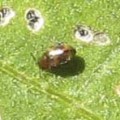[Intro text]
Botanical Information
Taxonomy
Zea mays
Poaceae family
History
Physical Description
Varieties & Cultivars
Categories or Types of Corn
Colors Available
Varieties (link to ../category/cultivars/tag/Corn)
Growth Requirements
Climate & Temperature Requirements
Air Temperature
Soil Temperature
Humidity
Day Length or Light Requirements
Site Conditions Favored
Soil Requirements
Soil Texture
pH
Nutrient Requirements
Propagation
Methods of propagation
Seed
Division
Cuttings
Transplanting or Potting Up
Seed Saving
Planting Out
Bed Prep & Soil Amendments
Bed Spacing
Row Spacing
Planting Depth
Alternative Bed Methods
Container Gardening
Routine Cultivation & Maintenance
Water Requirements
Fertilization Recommendations
Mulching & Weeding
Pinching or Pruning & Dividing
Support
Winterizing
Companion Planting
Helpful Companions
Harmful Companions
Companion to..
Pests, Diseases & Problems
Common Pests
Common Diseases
Symptoms
Whole Plant
Leaves
Stem/Trunk
Flowers
Fruit
Roots
Harvesting & Storage
Edible Parts of the Plant
Yield
Days to Harvest / Harvest Timing
- For sweet corn, when the silks at the top of the corn cobs dry out and turn brown, you’ll know it’s time to test one of the ears: gently pull down some of the husk on a corn ear and press your finger nail into a kernel; if the liquid is clear, the corn needs more time, but of the liquid is milky, then it’s time to harvest the corn VG
Harvest Methods
Storage of harvest
Fresh
Canned
Frozen
Pickled
Dried
Cooking
Nutritional Benefits & Values
- gluten free
- high levels of vitamin A
- high levels of vitamin B1 (thiamin)
- high in fiber
- Nixtamalization, soaking the kernel in an alkaline lime solution, allows the tough outer layers to be removed so it’s easier to grind into a paste, which also releases niacin and amino acids that are otherwise unavailable
- decent source of calcium (for a grain) especially when nixtamalized
- corn is an incomplete protein, but combining it with squash and legumes (the Three Sisters isn’t just for growing) makes up for its nutritional shortfalls
- one of the lowest protein contents of the grains (along with rice)
- cornmeal, when bought from the store, is often degerminated, which removes nutrition; package should say “whole corn” or “whole grain” or “stone ground”…or if you see lots of dark specks, then it’s probably not degerminated
Toxicity
Cooking
Preparation
Cooking Methods
Recipes (link to …/category/recipes/tag/Corn)
Resources
Information for this article was taken from these sources. (link to …/category/resources/tag/Corn)


